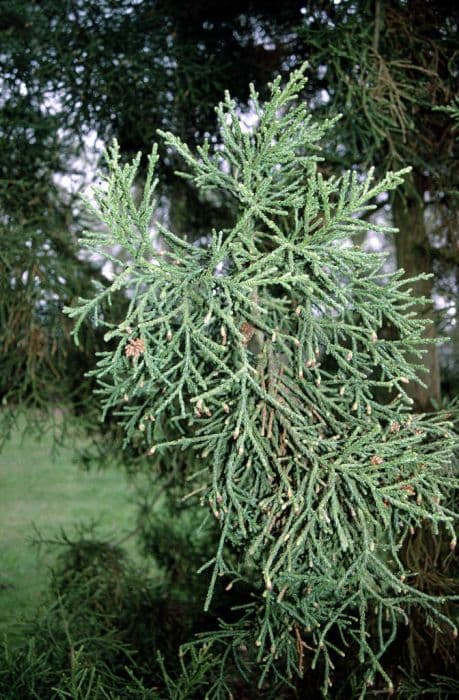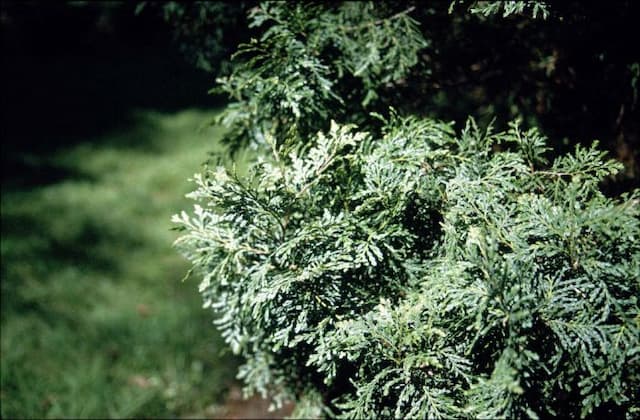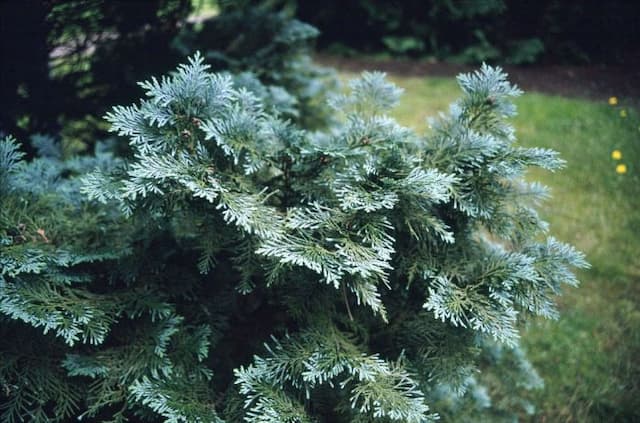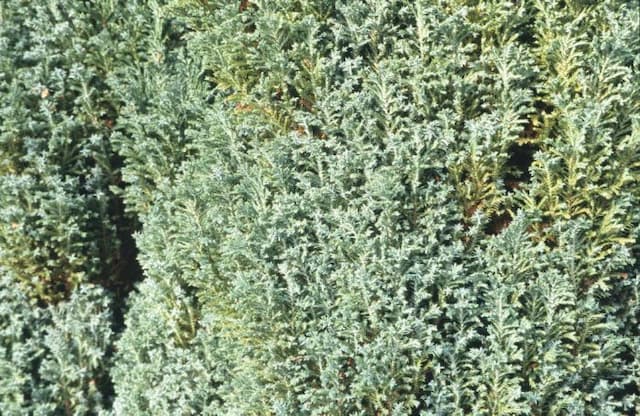Western Red Cedar Thuja plicata 'Aurea'

ABOUT
Thuja plicata 'Aurea', commonly known as the Golden Western Red Cedar, features distinctive golden-yellow foliage that makes it stand out prominently in garden landscapes. The foliage, which remains evergreen throughout the year, adds a bright contrast against the more common green hues of neighboring plants. Its leaves are scaled and arranged in a flat, spray-like pattern, providing a soft, textured appearance. As the name 'Aurea' suggests, the most striking characteristic of this cultivar is the golden-colored young leaves, which gradually become a warmer golden-green as they mature. The overall visual effect is of a shimmering golden plant, which can catch the sunlight and add a luminous quality to its surroundings. The Golden Western Red Cedar is known for its conical shape, which is broad at the base and tapers to a point toward the top. This naturally pyramidal form gives the plant a tidy, cultivated look even without pruning, making it a popular choice for hedges, screens, and as a specimen plant. Its branches are densely packed, adding to the sense of fullness and volume. The bark on the Golden Western Red Cedar is another defining feature, with a fibrous texture that can be attractive when the plant is viewed up close. This contrasts with the smoothness of the foliage, providing a wonderful play of textures for the onlooker. As a cultivar of a tree species originally native to western North America, it retains the resilience and adaptability of its parentage, making it a versatile choice for gardeners seeking a hardy yet visually appealing plant. The Golden Western Red Cedar is appreciated for both its beauty and its utility in a variety of landscape settings.
About this plant
 Names
NamesFamily
Cupressaceae.
Synonyms
Golden Western Red Cedar, Aurea Western Red Cedar, Yellow Western Red Cedar.
Common names
Thuja plicata 'Aurea'.
 Toxicity
ToxicityTo humans
Western Red Cedar ('Aurea' variety) has compounds that can be toxic if ingested. While not typically fatal, consuming parts of the plant can lead to gastrointestinal upset such as nausea, vomiting, and diarrhea. There is also the potential for skin irritation if handled extensively without protection.
To pets
Western Red Cedar ('Aurea' variety) is also toxic to pets if ingested. It can cause similar symptoms to those in humans, including gastrointestinal irritation like vomiting and diarrhea. In some cases, it may lead to more severe symptoms such as drooling, abdominal pain, and muscle weakness. It is important to prevent pets from chewing on or ingesting this plant to avoid potential poisoning.
 Characteristics
CharacteristicsLife cycle
Perennials
Foliage type
Evergreen
Color of leaves
Golden
Height
70 feet [21 meters]
Spread
15 feet [4.5 meters]
Plant type
Tree
Hardiness zones
5
Native area
North America
Benefits
 General Benefits
General Benefits- Ornamental Value: Western Red Cedar 'Aurea' is prized for its aesthetic appeal with its golden foliage that adds color and decorative interest to landscapes.
- Privacy Screening: Due to its dense growth habit, it is often used as a natural screen or hedge, providing privacy for homeowners.
- Windbreak: Its thick foliage serves as an effective windbreak, protecting homes and gardens from strong winds.
- Noise Reduction: The Western Red Cedar 'Aurea' can help dampen noise when planted in groups, useful in urban settings or near busy roads.
- Habitat for Wildlife: It offers shelter and nesting sites for birds while its cones provide food for various small mammals and birds.
- Low Maintenance: Once established, it requires minimal care, with only occasional watering and pruning needed to maintain its shape.
- Drought Tolerance: This cultivar has some drought resistance, making it suitable for regions with less frequent rainfall after it is rooted and established.
- Year-Round Interest: The Western Red Cedar 'Aurea' retains its foliage throughout the year, providing consistent visual interest in all seasons.
 Medical Properties
Medical PropertiesThis plant is not used for medical purposes.
 Air-purifying Qualities
Air-purifying QualitiesThis plant is not specifically known for air purifying qualities.
 Other Uses
Other Uses- Woodworking: Western red cedar wood is lightweight and rot-resistant, making it ideal for creating outdoor furniture, decking, and even musical instruments.
- Crafting: The soft, straight-grained wood is easily worked and can be used in making small decorative objects, carvings, or wooden toys.
- Boat Building: Traditionally, the wood of the Western red cedar was used by Indigenous peoples of the Northwest Coast for building canoes and other small watercraft due to its buoyancy and durability.
- Garden Structures: The wood's natural resistance to decay makes it suitable for constructing arbors, trellises, and other garden structures.
- Closet Linings: The pleasant scent of Western red cedar wood can be used to line closets or drawers, deterring moths and other insects naturally.
- Shingle and Siding Production: The wood has historically been used to manufacture roofing shingles and house siding, providing a durable and aesthetically pleasing finish.
- Sound Diffusion in Buildings: Because of its acoustic properties, the softwood can be used in interior design to help with sound diffusion in buildings, especially in spaces like concert halls and studios.
- Landscape Design: The 'Aurea' cultivar, with its golden foliage, is used as an ornamental plant in landscape design to add color contrast and visual interest to gardens.
- Privacy Screening: With its dense growth habit, the Western red cedar is often planted in rows as a natural privacy screen in residential and commercial landscapes.
- Fence Posts: Being rot-resistant, the wood is an excellent material for fence posts and other outdoor features that require longevity when in contact with soil.
Interesting Facts
 Feng Shui
Feng ShuiThe Western Red Cedar is not used in Feng Shui practice.
 Zodiac Sign Compitability
Zodiac Sign CompitabilityThe Western Red Cedar is not used in astrology practice.
 Plant Symbolism
Plant Symbolism- Protection: Thuja plicata 'Aurea', commonly known as Western Red Cedar, often symbolizes protection due to its durable wood that has been used historically to build strong and protective structures.
- Longevity: With its long lifespan, the Western Red Cedar represents endurance and the ability to withstand the tests of time, just like the tree itself.
- Cleansing: The tree is associated with purification and cleansing properties, as some cultures use the foliage in traditional steam baths and medicinal preparations to cleanse the body and spirit.
- Healing: As a plant used in various traditional medicines, Western Red Cedar symbolizes health and healing.
- Strength: The wood's resistance to decay relates to strength and resilience, symbolizing the ability to remain strong in the face of adversity.
 Water
WaterGolden Thuja, or Thuja plicata 'Aurea', should be watered deeply and thoroughly to ensure the root zone is moist. When first planted, water every couple of days allowing the soil to dry slightly between watering. As the plant establishes, reduce frequency to about once a week, or more during hot, dry spells. Provide approximately 1 to 1.5 gallons per watering for newly planted trees, ensuring you reach the entire root area. Water less frequently in fall and winter, typically every two to three weeks depending on weather conditions.
 Light
LightGolden Thuja thrives in full sun to partial shade. It prefers to be positioned where it can receive at least six hours of direct sunlight each day, but it can also tolerate some shade. For optimal growth and foliage color, place the Golden Thuja in a spot that is well-lit, avoiding deep shade or excessive exposure to hot afternoon sun.
 Temperature
TemperatureGolden Thuja is cold hardy and can withstand temperatures as low as -20°F to -30°F, which makes it suitable for growing in many climates. The ideal temperature range for optimal growth is between 50°F and 70°F during the day. The plant will also tolerate summer heat as long as the regions do not persistently exceed 80°F to 90°F.
 Pruning
PruningThe Golden Thuja should be pruned to maintain desired shape and size. It's best to prune in late winter or early spring before new growth starts, but light pruning can be done at any time of year. Pruning is generally needed once or twice a year; always use sharp, sterile tools to make clean cuts. Periodic thinning of dense foliage can also promote better air circulation within the plant.
 Cleaning
CleaningAs needed
 Soil
SoilWestern Red Cedar 'Aurea' grows best in a well-draining soil mixture with a pH range of 6.0 to 8.0. Incorporating compost or aged bark will enhance soil structure and nutrients. Adding perlite or pumice can improve drainage, which is critical for preventing root rot.
 Repotting
RepottingWestern Red Cedar 'Aurea' is a large, slow-growing tree that typically does not require frequent repotting. It is usually planted outdoors and its root system will naturally expand into the surrounding soil without the need for repotting. Repotting is generally not applicable to this species once established outdoors.
 Humidity & Misting
Humidity & MistingWestern Red Cedar 'Aurea' is adaptable to a wide range of humidity levels outdoors. It can tolerate the naturally occurring humidity in its growing zones and does not require any special humidity considerations when planted in the landscape.
 Suitable locations
Suitable locationsIndoor
Not suited for indoor growth; requires outdoor space to thrive.
Outdoor
Plant in moist, well-draining soil; full sun to partial shade.
Hardiness zone
5-7 USDA
 Life cycle
Life cycleThe Western Red Cedar 'Aurea', which is a cultivar of Thuja plicata, begins its life cycle with seed germination where the conditions are cool and moist. After germination, the seedling grows into a juvenile tree, establishing a root system and beginning to develop the characteristic golden-yellow foliage. As it matures into adulthood over several years, it experiences vigorous growth and assumes a pyramidal shape with dense, evergreen foliage, which is maintained throughout its life. The mature tree then produces cones, small and oblong in shape, which contain the seeds for the next generation. Pollination occurs typically with the help of wind, and once fertilized, the cones release seeds to germinate in appropriate conditions. The Western Red Cedar 'Aurea' can live for many decades, even centuries, in the right environment, continuously growing, reproducing, and contributing to the ecosystem until it eventually dies, decomposes, and returns nutrients to the soil.
 Propogation
PropogationPropogation time
Spring-Early Summer
The Western Red Cedar 'Aurea' can be propagated most successfully through semi-hardwood cuttings. This typically involves taking a cutting of about 4 to 6 inches (10 to 15 centimeters) from a healthy parent plant during the late summer or early autumn. The bottom inch of the cutting should be stripped of foliage, and a rooting hormone can be applied to enhance root development. The prepared cutting is then placed in a well-draining potting mix or propagation medium, ensuring that at least one or two nodes are buried where leaves have been removed. It is important to maintain a humid environment until roots have established, which can be supported by placing a plastic bag or a propagation dome over the cutting. Steady but indirect light is preferable during this process to prevent overdrying or burning of the tender new growth. Once rooted, the new plant can be gradually acclimated to less humid conditions before being transplanted to its final location.









